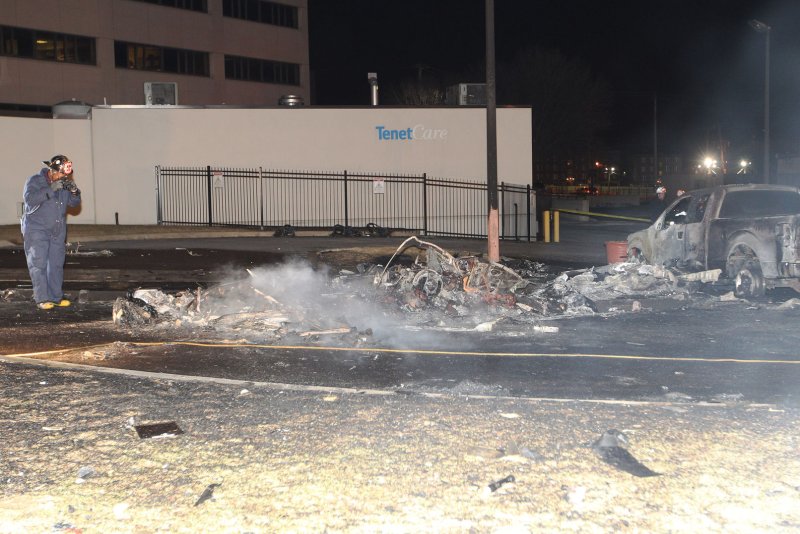A St. Louis Fire Department investigator looks at the smoldering wreckage of a helicopter crash at Saint Louis University Hospital in St. Louis on March 6, 2015. According to fire officials, the Arch medical helicopter was arriving at the hospital to pick up a crew when the crash occurred. The pilot, who was killed, was the only person aboard. Photo by Bill Greenblatt/UPI |
License Photo
BALTIMORE, Oct. 2 (UPI) -- Changes to protocol for transporting trauma patients to the emergency room by ambulance rather than helicopter resulted in some patients needing additional care but no changes to expected levels of mortality, a decade-long study of emergency transport in Maryland found.
The state of Maryland, as well as the National Transportation Safety Board, made changes to how transport decisions are made in 2004, 2007 and 2008, based at least partially on aeromedical transport costing between 5 and 15 times more than ground transportation.
Nine fatal helicopter EMS crashes in 2008, which killed 35 people, inspired drastic changes in decision-making as well, which researchers said has had a good overall effect.
"Purported benefits of HEMS are derived from enhanced crew expertise and decreased time to deliver seriously injured patients to trauma centers," said Dr. Jon Mark Hirshon, an associate professor at the University of Maryland School of Medicine, in a press release. "However, by shifting to a new protocol that increased ground transports and decreased air transport for less critical patients, we improved patient outcomes while saving the state considerable money. Those are wins all around."
The protocol changes initially recommended that patients within a 30-minute drive be transported by ambulance, and that a physician authorize helicopter transport for patients in certain trauma categories regardless of distance. The recommendations were later changed to a requirement.
Researchers analyzed data from the helicopter EMS computer-aided dispatch database for in-state flights and from Maryland's state trauma registry to find levels of patient transportation between July 2000 and June 2011.
Over the course of the 11-year study period, they found a 44,073 helicopter transports in the dispatch database, which revealed a 55.9 percent decrease in helicopter use over the period. The trauma registry showed 182,129 total patients, including 37,407 HEMS transports, 128,129 ambulance rides, and 17,273 transfers -- this equated to an increase of 21 percent overall annual EMS trauma patients transported, a 33 percent increase in ground transports, and a 49 percent decrease in helicopter EMS transports.
"New field triage protocols were associated with fewer flights but better expected outcomes, despite having more seriously injured patients," Hershon said. "Future research is required to confirm our findings and determine when helicopter EMS can offer the most benefit."
The study is published in Annals of Emergency Medicine.















